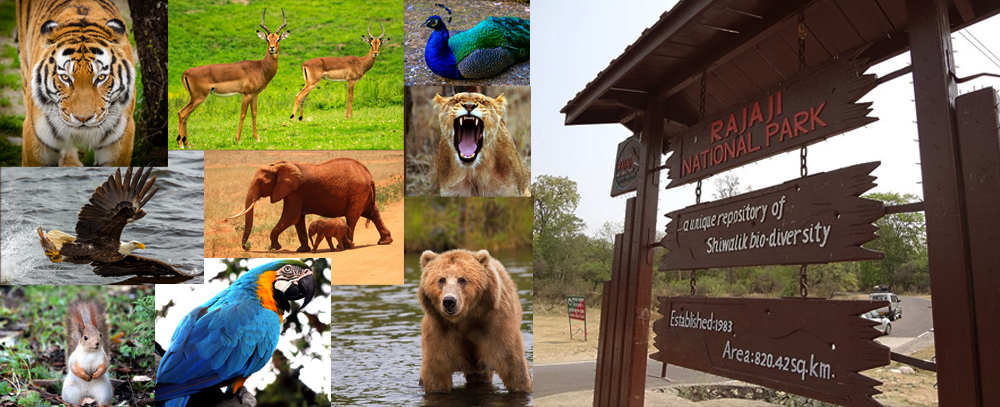
Rajaji National Park in Rishikesh now became Tiger Reserve National Park. It will be the second tiger reserve in the State Uttarakhand after the Corbett National Park. There are at present 42 tiger reserves in the country. In announcement said that tiger reserve at the Rajaji National Park in Rishikesh would cover an area of 1,150 sq.km, including Shyampur of the Haridwar forest division, Kotdwar and Laldhang ranges.
The park was constituted combining three existing wildlife sanctuaries, viz Rajaji, Motichur and Chila. The park is spread over an area of 820 sq km and falls in Uttaranchal state. The Rajaji national park is named after late Shri C, Rajgopalachari, popularly known as Rajaji. Its altitudinal range varies from 300m to 1350m. Dehra Dun, Rishikesh and Haridwar are located in the surroundings of the park.
The park with its magnificent ecosystem, is nestled in the Shivalik hills and lying between the lower Himalaya and upper Gangetic plians. The Principal tributaries of the Ganga inside the park are Song, Suswa and Rawsoan rivers besides many minor streams.
It represents the flora and several zones of the forests riverine, broad leaf mixed forest, pine forest, scurb land and grassy pasturelands.
There are as many as 23 species of mammals and 315 avi fauna here. It is the northwestern most habitats of the Asian Elephant. The season to visit the park is from November 15th to June 15th.
Flora of the Park
The vegetation of Rajaji is predominantly sal forest of which several sub type, viz. Moist Shivalik Sal, Moist Bhabar Dun Sal and Dry Shivalik Sal, cover 75 % of the park. Other common tree species are:
Terminalia tomentosa, T. balerica, Cassia Fistula, Anogeissus latifolia, Dalbergia sisssoo, Acacia catechu, Bombax ceiba, Ficus bengalensis, Mallatus phillippensis, Dendrocalanus strictus. Rohini is a very common smaller tree of the park and forms a major item of the elephant’s diet. Common grasses of the park include Heteropogon contortus , Eulaliopsis binata and Chrysopogon fulvus etc.
Project Elephant
The Asian Elephants are found in the large area between rivers Sharda (Tanakpur) and river Yamuna. For the conservations of elephants, Project Elephant has been stared.
Presently the scheme is being implemented in Rajaji national park, Sona Nandi Wildlife sanctuary and related areas.
Fauna of the Park
Corresponding to the considerable diversity of habitat types, the fauna of the park shows a good variety of species.
Mammals
Herds of elephants, tiger, leopard, Jungle cat, Himalayan yellow throated marten, sambar, chital, porcupine, barking deer, wild boar, sloth bear, goral and civet.
Avian species
Peafowl, jungle fowl, kaleej pheasant, horn bill, wood peaker, thrushes, king fisher, parakeet, warbler, finch , Indian roller, oriole etc and several species of migratory birds particularly seen in the winter season.
Reptiles
Monitor Lizard, Python, King cobra, Krait etc.
Insect fauna includes butterflies, Bess, bugs bettles etc.
The park can be visited from morning to evening. Use of air polluting articles such as transistors, tape recorders, radio etc and flashlights etc are strictly prohibited in the park area.
Accessibility
The park is accessibility by rail and motor road from Dehra Dun, Rishikesh, Haridwar and Delhi. The entry points are at Mohand and Ranipur.
Prices for Rajaji National Wildlife Safari Park
| Individual/Group | Indians | Foreigners |
|---|---|---|
| 1 Person | 2700 | 3300 |
| 2 Person | 2900 | 4100 |
| 3 Person | 3100 | 4900 |
| 4 Person | 3300 | 5700 |
| 5 Person | 3500 | 6500 |
| 6 Person | 3700 | 7300 |
Price Structure for above Individual/Group package
| Price Structure | Indians | Foreigners |
|---|---|---|
| Open Zipsy Cab for 1-6 people | 2000 | 2000 |
| Fix Road Tax on Zipsy upto 6 people | 500 | 500 |
| Entrance Fees | 200 | 800 |
Timings for Rajaji National Park & Wildlife Safari
(Winter Timings – 15th November to 31st March)
Morning – 7:00 AM to 10:00 AM, Evening – 1:00 PM to 2:30 PM
(Summer Timings – 1st April to 30th June)
Morning – 6:00 AM to 9:00 AM, Evening – 3:00 PM to 5:00 PM
Rules to visit Rajaji National Park Wildlife Safari
Keep silence for better chance to view animals. Shouting, teasing & chasing animals is prohibited. Do not get down from your jeep except designated points.
Plastic is prohibited in park.
How to reach Rajaji National Park
Rajaji National Park is well connected by road. New Delhi is only 230 kms far from here. Haridwar Railway station is just 20 kms far from here. 20 km from
Rishikesh & Dehradun Jollygrant Airprt is just 35 kms far from here.
.png)












